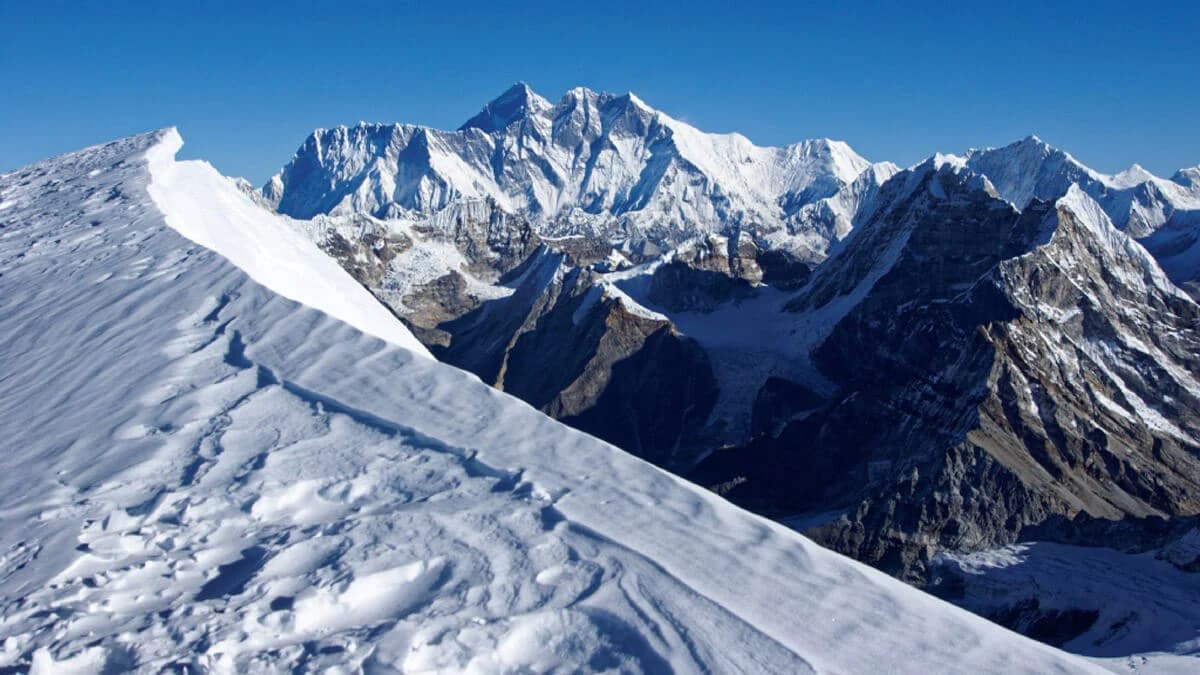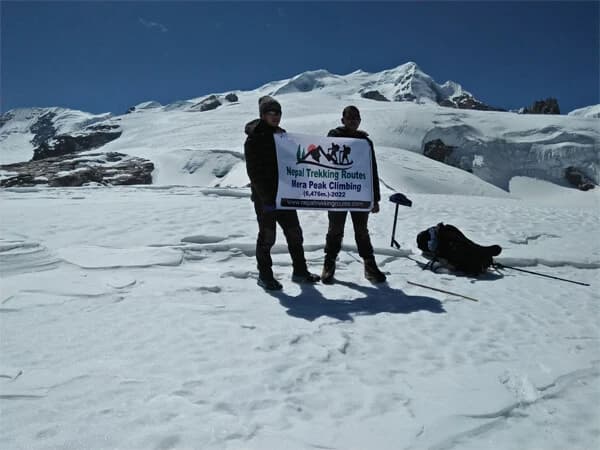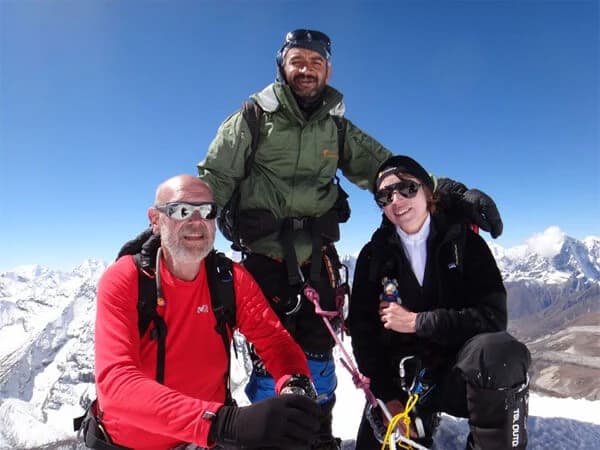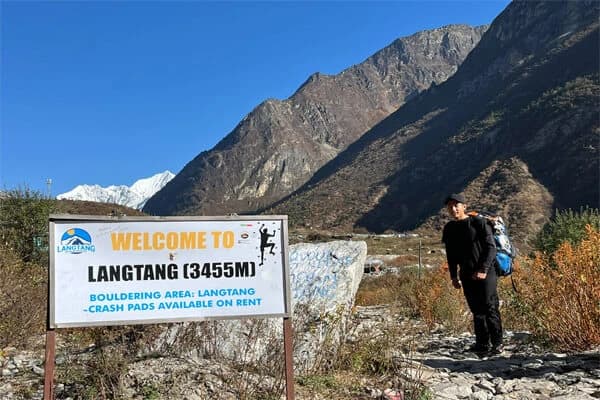Mera Peak Climbing is an excellent choice for people seeking their first Himalayan mountaineering experience. Standing tall in the Makalu Barun area, it provides climbers with amazing views of Everest, Makalu, and other Himalayan giants. The climb is difficult yet manageable, making it suitable for new and experienced climbers looking to put their talents to the test. A successful ascent requires proper acclimatization, physical preparation, and reliable supervision.
Mera Peak Climbing Guide
What makes Mera Peak so unique among climbers and trekkers? Mera Peak is one of the most prominent trekking peaks of Nepal, reaching 6,476 meters. It is commonly referred to be a "beginner's climbing peak," but do not be fooled. Climbing Mera Peak is still a significant achievement due to its high altitude and the effort required. Unlike technical mountains that need significant climbing abilities, Mera Peak is more about stamina, consistent progress, and the ability to deal with thin air. This makes it the ideal peak for travelers who wish to feel the rush of standing on a Himalayan summit without requiring years of climbing experience.
The climb offers stunning views of some of the world's tallest peaks, including Everest, Makalu, Cho Oyu, Lhotse, and Kanchenjunga. Many trekkers chose Mera Peak as their first Himalayan climb because it combines challenge, beauty, and cultural exploration. The route takes you through isolated valleys, traditional Sherpa communities, and beautiful forests before entering the freezing realm of glaciers and high-altitude climbs.
This blog, the Mera Peak Climbing Guide, will lead you through all you need to know, from preparation and expense to safety precautions, so you can confidently plan your adventure.
Location and Significance
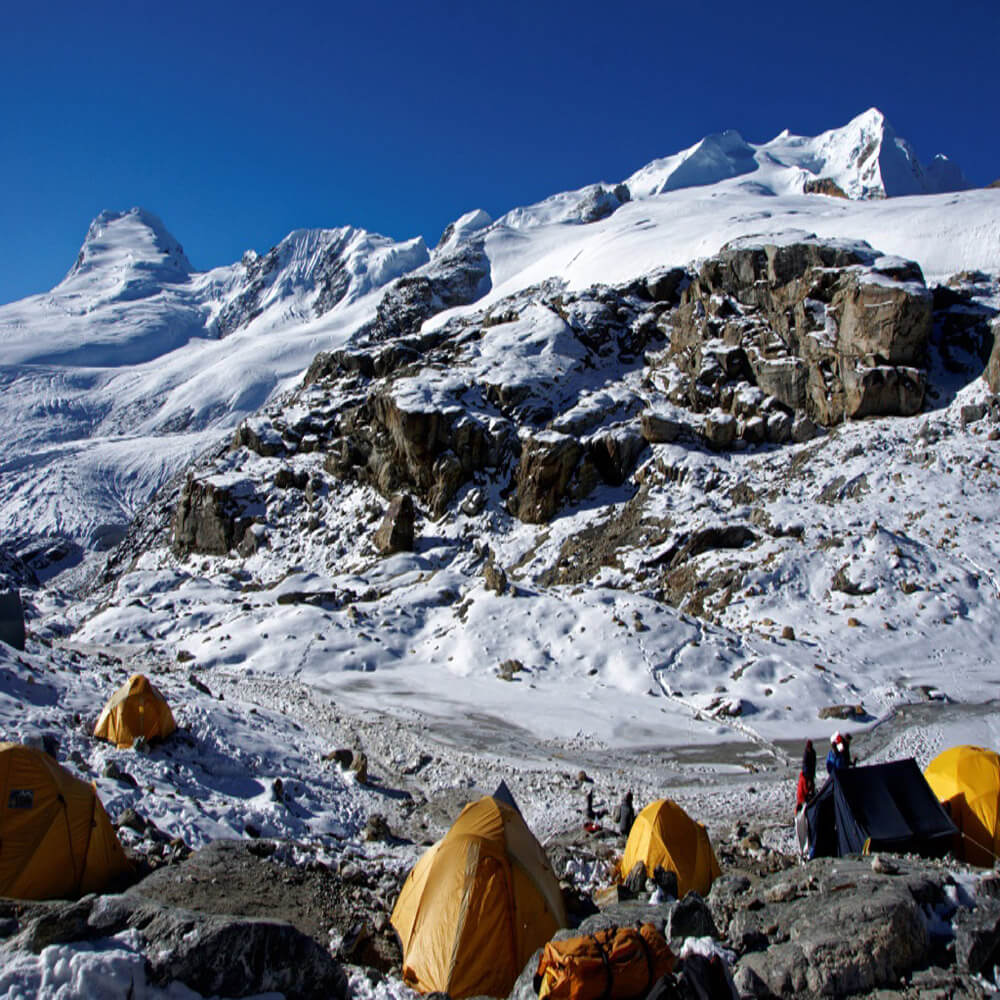
Mera Peak is located in the isolated Makalu-Barun area, directly east of the Mount Everest Region. At 6,476 meters, it is Nepal's highest trekking peak, making it a great alternative for adventurers looking to experience the excitement of high-altitude climbing in Nepal without facing the extreme technical demands of the world's tallest peaks. The approach to Mera is an adventure in and of itself, with climbers passing through rhododendron forests, lonely towns, and vast alpine landscapes before reaching the glaciers and high camps.
A professional Mera Peak expedition guide would constantly emphasize that the mountain is more than simply the climb; it is also about the journey. Along the route, you will come across Sherpa towns, Buddhist monasteries, and scenic valleys that highlight the Himalayas' cultural richness. His combination of natural beauty and cultural immersion makes the trek more meaningful and memorable.
Mera Peak is geographically unique, with breathtaking views from its summit. On a clear day, climbers may see five of the world's tallest peaks: Everest, Lhotse, Cho Oyu, Makalu, and Kanchenjunga. This panoramic view alone makes the effort worthwhile and contributes to the peak's unique significance.
In short, Mera Peak is more than just a climb; it is a voyage into the heart of Nepal's mountains and culture. Following a reliable Mera Peak expedition guide is the first step toward a safe and rewarding adventure for anyone looking to begin their journey into high-altitude climbing in Nepal.
Best time for Mera Peak climbing
When organizing an excursion such as this, timing is everything. The best time for Mera Peak climbing is usually during the two main trekking seasons in Nepal:
Mera Peak Climbing in spring season (March to May) and autumn (September to November). These months feature consistent weather, bright sky, and excellent visibility of the neighboring Himalayan giants, such as Everest, Lhotse, Makalu, and Kanchenjunga. In the spring, the pathways are lined with blooming rhododendrons, providing beauty to the ride before you reach the upper elevations. Autumn, on the other hand, brings fresh air and breathtaking mountain views once the summer rain has passed.
Mera Peak Climbing in Winter (December to February) might also be an option for climbers seeking isolation, although the intense cold, thick snow, and fewer days make it more challenging. Similarly, excessive rainfall, slippery trails, and limited visibility make the monsoon season (June to August) unsuitable.
Choosing the proper season boosts your chances of having a safe and rewarding Mera Peak summit experience. During the optimal months, snow conditions are more predictable, the ascending route is clearer, and your body has a greater opportunity of adjusting to the altitude without being forced by harsh weather. Standing on top of Mera Peak is about more than just reaching the summit; it is about savoring the journey the quiet routes, the high camps, and, finally, the magical moment when the Himalayan vista unfolds before you. Picking the proper moment guarantees that your adventure is both safe and breathtaking.
Route Options and Itinerary
The Mera Peak climbing route begins with a picturesque flight from Kathmandu to Lukla, the gateway to the Everest region. Trekkers leave Lukla and go through tranquil villages, rhododendron forests, and river valleys to reach the isolated Hinku Valley. Unlike the popular Everest Base Camp path, the trail to Mera feels tranquil and unspoiled, allowing climbers to explore both environment and culture. There are two primary approaches: one by Zatrwa La Pass, which is shorter but steeper, and a longer, classic route through Paiya and Panggom, which allows for more progressive acclimatization.
A regular Mera Peak climbing itinerary typically lasts 17 to 20 days, depending on the route and acclimatization requirements. Climbers spend an extra day practicing fundamental mountaineering skills such as crampon, ice axe, and rope procedures after they get at Khare, the last hamlet before the climb. The trail continues from Khare to Mera Peak High Camp, which is located on a rocky outcrop at an elevation of around 5,800 meters. This camp gives an ideal location to relax and prepare for the summit attempt.
The summit push begins before daylight, as climbers traverse snow slopes and mild ridges. The climb is not challenging, but it takes energy and appropriate pacing. Climbing to the summit of Mera Peak (6,476m) rewards climbers with breathtaking views of Everest, Makalu, Cho Oyu, Kanchenjunga, and Lhotse. After reaching the summit, trekkers return to Lukla over the same trail to catch a flight to Kathmandu, capping off an epic Himalayan experience.
Mera Peak permits and regulations
If you intend to climb Mera Peak, obtaining the necessary documentation is just as crucial as preparing your body. The most crucial need is the Mera Peak permits and regulations given by the Nepal Mountaineering Association (NMA). Every climber must obtain a Mera Peak climbing permit, and the cost varies depending on the season. Spring and autumn are more expensive, although winter and summer are slightly cheaper. In addition to this climbing permit, you will require an access permit to Makalu Barun National Park, which includes Mera Peak. A TIMS (trekkers' Information Management System) card is also necessary to keep track of trekkers in the area for safety reasons.
Most climbers obtain their permits from a certified trekking agency in Kathmandu. This is the most convenient method because the laws can change, and agencies are up to speed on the most recent Mera Peak permits and regulations. Typically, your tour begins in Kathmandu, when your agency gets all necessary documentation before flying to Lukla. The Kathmandu to Mera Peak trek continues through picturesque villages, alpine woods, and high passes before arriving at Khare, the base camp.
It is critical to maintain all of your permits with you throughout the walk, since they may be checked at several access points. Following the legal process not only protects you, but it also benefits local communities and conservation programs in the region. With the correct permits, your Mera Peak experience will be seamless and worry-free.
Difficulty Level and Acclimatization
When planning your climb, two key considerations are the Mera Peak Climbing difficulty level and the obstacles of Mera Peak altitude and acclimatization. Many tourists select Mera Peak since it is one of Nepal's highest trekking peaks and does not require extensive technical climbing skills. The ascent is largely non-technical, with moderate snow and ice slopes, but certain sections require the use of crampons, ropes, and an ice axe. This makes it ideal for fit trekkers with basic mountaineering training or previous high-altitude trekking experience.
The altitude, more than the steepness or technicality of the ascent, is the most difficult task. Standing at over 6,400 meters, the Mera Peak altitude and acclimatization element has a significant impact on whether you succeed or not. At this elevation, the oxygen level in the air is significantly lower than what your body is accustomed to, increasing the risk of altitude sickness. That is why itineraries include adequate rest and acclimatization days along the route.
To ensure a safe transition, trekkers typically spend extra days at Khare or other midpoints to allow the body to gradually adjust. Walking gently, taking enough of water, and following your guide's recommendations are critical to success. In short, the Mera Peak difficulty level is rated moderate, but the altitude makes the ascent challenging. Good fitness, steady pacing, and careful acclimatization will greatly increase your chance of reaching the summit.
Training and Preparation
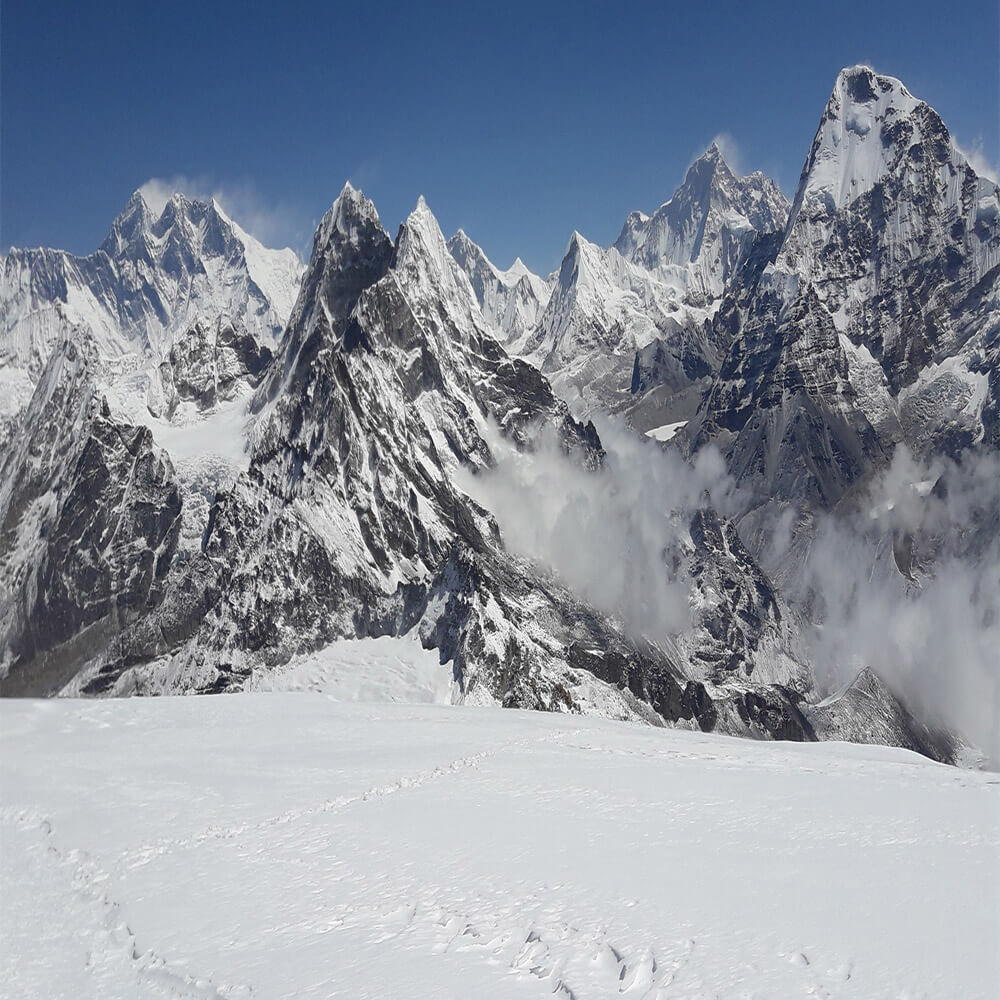
Mera Peak may be known as a "trekking peak," but reaching its summit at almost 6,400 meters requires prior preparation. Many climbers make the mistake of believing it is a simple walk-up, but the high altitude and long days can test even the fittest trekkers. That is why Mera Peak climbing preparation should begin several months before the actual adventure.
First, work on increasing stamina. Long backpack trips, uphill walking, and cardio exercises like running, cycling, or swimming can all help to improve your lungs and legs. Consistency is more important than intensity, so workout four to five times each week. Strength training is also beneficial, particularly for the core, shoulders, and legs, as you will be carrying your own equipment and moving up steep hills. It is equally necessary to practice with a laden backpack. Carrying 8-12 kg on uneven trails during training will prepare your body for the challenges of Himalayan terrain. Before climbing Mera Peak, try trekking in your home country or joining shorter climbs in Nepal. These experiences boost confidence and help you realize your limitations.
In addition to physical conditioning, you must have fundamental mountaineering skills. During your training for Mera Peak expedition, learn how to use crampons, an ice axe, and a harness. Rope skills, glacier travel, and self-arrest practice can improve your safety and confidence. With consistent training, both physically and technically, Mera Peak becomes a pleasurable goal rather than an intimidating challenge.
Essential Gear and Equipment for Mera Peak Climbing
When planning for a Himalayan expedition, having the appropriate equipment might mean the difference between a safe and pleasurable climb and a challenging one. A proper Mera Peak climbing guide constantly highlights the necessity of equipment, as the mountain's high altitude and snowy conditions necessitate meticulous preparation.
There are two types of equipment for Mera Peak climbing: personal trekking gear and technical climbing gear. Personal trekking gear consists of high-quality trekking boots, layered clothes for both warm and cold weather, a down jacket, warm gloves, a sleeping bag rated for sub-zero temperatures, and a durable backpack. Because temperatures fluctuate quickly, layering is vital for keeping the body comfortable.
Climbers will require technical equipment such as crampons, an ice axe, a climbing harness, a helmet, ropes, and carabiners. These tools are essential for safety when crossing glaciers or climbing steep terrain. Many climbers prefer to rent this equipment in Kathmandu or Lukla, but having your own provides familiarity and comfort.
Other essentials include UV-protected sunglasses, torches, water bottles, and trekking poles. Hydration systems, energy foods, and a personal first-aid pack are all highly suggested.
This MeraPeak climbing guide warns climbers that, while agencies typically provide group gear such as ropes and tents, each individual must bring personal needs. Investing in high-quality equipment boosts your chances of reaching the peak while also keeping you safe in unexpected mountain circumstances.
Accommodation and Food on Mera Peak Route
When planning a climb, deciding where you will rest and eat is just as crucial as packing your kit. On the Mera Peak trekking route, trekkers will discover a variety of lodges and camping areas to meet their demands and comfort levels. Lodges and camping on Mera Peak trek route offers a range of possibilities, from basic tea shops to organized camping at high camps, ensuring climbers have enough rest before attempting the summit.
There are numerous villages along the trekking path from Lukla to the base of Mera Peak that offer simple lodges. These lodges provide warm meals such dal bhat, noodles, and soups, which are crucial for maintaining energy levels. As you go near Khare and Mera High Camp, lodges become increasingly rudimentary, and room becomes scarce. Camping is particularly useful in this situation. Climbers typically rely on trekking agency-set up tents at higher altitudes, which provide shelter from cold winds and allow for a decent night's sleep.
Carrying a lightweight sleeping bag appropriate for sub-zero conditions is required, as is a tiny portable stove or relying on the agency's kitchen setup. Mera Peak climbing guide strongly recommends organizing meals in advance, guaranteeing sufficient hydration and nutrition throughout the trek. Choosing a combination of lodges and camping along the route provides climbers with flexibility, safety, and comfort, making the climb more pleasurable and less taxing. Trekkers who plan for both types of lodging can concentrate on the ascent and thoroughly appreciate the stunning Himalayan surroundings.
Mera Peak climbing cost
When planning a Mera Peak climb, it is critical to understand the Mera Peak climbing cost to avoid surprises. The final cost is determined by various factors, including the length of the trek, the quality of accommodation, and whether you employ a professional guide or a climbing agency. A typical 18-20 day adventure might cost between $2,500 and $4,000 per person when booked through a reputable trekking organization.
The main components of the Mera Peak climbing cost are permits, which are required. Climbers must first get a Mera Peak climbing permit from the Nepal Mountaineering Association, followed by a national park entry permit if trekking through the Makalu-Barun region. These official fees are set but contribute significantly to the entire cost.
Hiring a professional guide and, if necessary, porters adds significantly to the expense. A certified guide assures safety, assists with tough climbing portions, and offers useful acclimatization advice. Many climbers prefer full-service companies that include meals, tea-house accommodations along the trekking path, and camping equipment at higher altitudes.
Travel costs, such as flights to Lukla and local transportation, must also be addressed. Additionally, gear rental or personal equipment increases the overall budget.
Climbers can enjoy the climb without financial stress if they prepare well and use a reputable Mera Peak climbing guide. Partnering with our company, Nepal Trekking Routes guarantees that logistics and safety are expertly managed, making the Mera Peak trip enjoyable and unforgettable.
Hiring Guides and Porters
Climbing Mera Peak is a thrilling journey, but it is not without problems. The correct assistance can mean the difference between a successful summit and a dangerous climb. A Sherpa guide for Mera Peak is more than just a guide; they are skilled mountaineers who are familiar with the region's geography, weather patterns, and safety protocols. Their knowledge assists climbers in navigating tricky portions, managing altitude sickness, and maintaining the appropriate pace for acclimatization.
Throughout the trek, a Mera Peak climbing guide provides vital training and preparation recommendations. They guarantee climbers are confident and well-prepared for the summit push by teaching them how to use crampons and ice axes and handle ropes. Many climbers underestimate the necessity of having someone who can analyze mountain conditions in real time, which is where a Sherpa guide comes in handy.
Porters are another important aspect of a safe and comfortable climb. They transport heavy equipment, tents, and food, allowing climbers to move more freely and concentrate on the climb. Hiring a professional guide and porter team not only boosts your safety, but also improves your overall experience, allowing you to enjoy the beauty and immerse yourself in Himalayan culture without undue worry.
When arranging a Mera Peak adventure, work with a licensed trekking organization to verify that your Sherpa guide for Mera Peak and support team are experienced and trustworthy.
Safety and Challenges
When ascending Mera Peak, safety should always be a primary priority. Following "safety tips for Mera Peak climbing" can mean the difference between a successful ascent and a disastrous situation. Altitude sickness is one of the most significant concerns. Even though Mera mountain is classified as a trekking mountain, it rises above 6,400 meters, and the air becomes thinner at higher elevations. Always rise gradually, take rest days for adequate acclimatization, and pay attention to your body's signals.
The weather in the Himalayas can be unpredictable. Snowstorms, strong winds, and unexpected temperature decreases are common. Always check the forecast and come prepared with layered clothing, waterproof gear, and sturdy boots. If you plan to climb the peak's upper sections, bring vital safety equipment such as a harness, helmet, crampons, and an ice axe.
Having an expert guide and a trained support team is essential. Guides not only help climbers cross difficult terrain, but they also look for signs of altitude sickness and other hazards. Following their advice is one of the most critical Mera Peak climbing guide tips.
Other safety tips for Mera Peak climbing include carrying a first-aid kit, staying hydrated, snacking frequently, and being ready for emergency evacuation if necessary. Also, ensure that your trekking insurance covers high-altitude climbs.
Your Mera Peak climb may be both safe and rewarding if you take the necessary precautions, respect the mountain, and plan appropriately. Always remember that the top is significant, but getting there safely is the actual accomplishment.
Cultural and Scenic Highlights
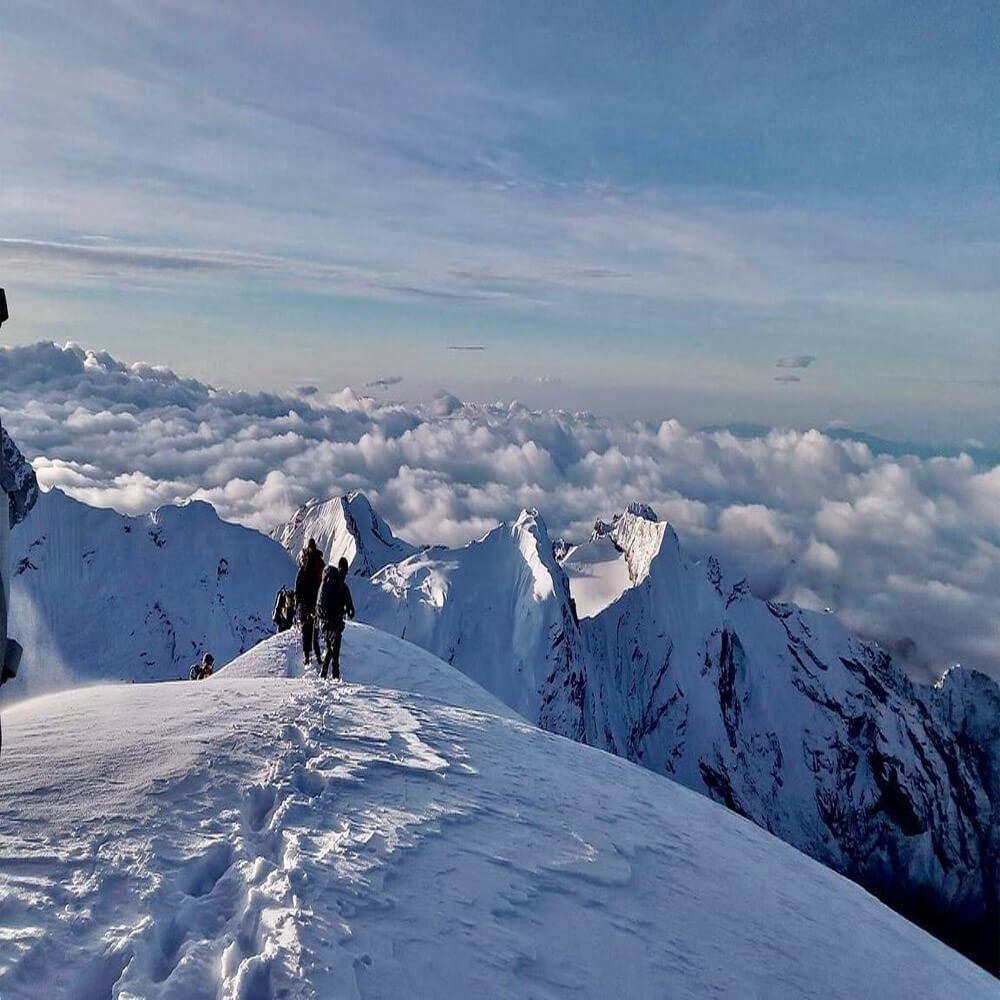
Climbing Mera Peak is much more than just reaching the peak; it is about seeing the distinct culture and stunning environment of Himalayas. Along the way, trekkers travel through traditional Sherpa communities, where they may observe native life and hospitality. Small tea rooms and lodges provide insight into the everyday routines, celebrations, and customs of the people who have lived in these mountains for generations. Observing their rituals, dressing traditionally, and eating local cuisine can make your trip lot more rewarding.
The scenery along the Mera Peak path is similarly breathtaking. From beautiful rhododendron forests in the lower parts to rough, snow-covered terrain near high camps, each step provides a fresh perspective. On a clear day, climbers may see some of the world's biggest mountains, including Everest, Makalu, and Cho Oyu. The sunrise and sunset from high-altitude camps are especially beautiful, illuminating the Himalayan peaks in golden light.
When arranging an adventure, consider combining group and private Mera Peak trips to optimize your experience. Group tours give companionship and shared supervision, but private trips allow greater flexibility, individualized timetables, and direct engagement with guides. Using a detailed Mera Peak climbing guide ensures that you do not miss these cultural and scenic attractions, allowing you to experience both the natural beauty and the rich local customs. Mera Peak's combination of culture, beauty, and summit adventure creates an unparalleled Himalayan experience.
Mera Peak vs Island Peak
Mera Peak and Island Peak are two of Nepal's most popular trekking peaks, with each providing a unique climbing experience. Both are regarded adequate for novices with some trekking experience, however the terrain, scenery, and approach vary.
- Difficulty Level: Mera Peak is often easier, having a gentle ascent and less technical climbing. It is perfect for climbers seeking a high-altitude experience without difficult ice or rock problems. Island Peak, on the other way, is more technical, requiring climbers to utilize crampons and ice axes on steep slopes, therefore it is better suited to individuals with prior climbing experience.
- Scenery and Views: Mera Peak has stunning panoramic views of the world's five highest mountains, including Everest, Lhotse, and Makalu. Island Peak offers breathtaking vistas of the Everest region, particularly Ama Dablam, and a towering summit ridge that adds to the climb's visual appeal.
- Accessibility and Trekking Routes: Mera Peak is accessible via the quieter and less congested Hinku and Makalu regions. Island Peak is accessible by the popular Everest Base Camp trek route, which is busier but has well-established lodges and support.
- Experience Level: Choose Mera Peak for a more pleasant, scenic ascent, or Island Peak for a more strenuous, technical challenge. Both summits offer amazing Himalayan experiences.
Tips for a Successful Climb
Climbing Mera Peak is an exciting adventure, but careful planning and smart decisions make the experience safer and more enjoyable. Here are some practical tips to help you succeed:
- Acclimatize Properly: Take your time on the trek and at higher camps. Avoid rushing to the summit to reduce the risk of altitude sickness.
- Listen to Your Guide: Your guide knows the route and the mountain conditions. Always follow their instructions, especially in tricky areas.
- Pack Light but Smart: Carry essential clothing, climbing gear, water, snacks, and first-aid items. Avoid unnecessary items that can weigh you down.
- Stay Hydrated: Drink plenty of water throughout the trek. Proper hydration helps with energy levels and altitude adjustment.
- Dress in Layers: Weather can change quickly in the Himalayas. Use thermal layers, waterproof jackets, and windproof gear to stay warm and dry.
- Train Beforehand: Strengthen your legs, core, and cardio fitness before the expedition. Practice trekking with a backpack to build endurance.
- Rest Well: Sleep is important for recovery and acclimatization. Take breaks during the day and maintain a good sleep routine at camps.
- Maintain a Positive Attitude: Climbing can be challenging, but a patient and determined mindset helps you overcome obstacles and enjoy the journey.
Following these tips ensures a safer, more enjoyable, and successful Mera Peak experience.
Mera Peak climbing FAQs
What is the best time to climb Mera Peak?
The best time is during spring (March–May) and autumn (September–November). These months offer clear skies, moderate temperatures, and good visibility. Monsoon (June–August) and winter (December–February) are less ideal due to heavy snow, rain, or extreme cold.
How difficult is Mera Peak?
Mera Peak is considered a trekking peak, suitable for beginners with some trekking experience. While the climb involves high altitudes and basic mountaineering skills, it is less technical than other Himalayan peaks. Proper acclimatization and fitness are crucial.
Do I need a guide or porter?
Yes, hiring a licensed guide is highly recommended for safety, route navigation, and permit arrangements. Porters can help carry heavy gear, making the climb more comfortable. Agencies like Nepal Trekking Routes provide experienced guides and porters.
What permits are required?
You need a Mera Peak climbing permit, TIMS card, and Makalu-Barun National Park entry permit. Your guide or trekking agency usually handles these permits in advance.
How much does it cost to climb Mera Peak?
The cost varies depending on the package, including permits, guide, porter, equipment, food, and accommodations. On average, a 14–16 day expedition ranges from $2,000 to $3,500 per person, depending on the service level.
Conclusion: Mera Peak Climbing Guide
Mera Peak provides an excellent start to Himalayan climbing. It mixes the thrill of achieving a high summit with stunning vistas of Everest, Makalu, and the surrounding peaks. For those new to climbing, it offers a tough but doable goal, making it ideal for developing confidence and skills. Careful planning, adequate acclimatization, and a dependable support team are required for a safe and pleasurable ascent. Working with qualified guides and local organizations, such as Nepal Trekking Routes, guarantees that you receive competent assistance with permits, logistics, and on-the-ground support. Climbing Mera Peak is more than simply an adventure; it is a memorable tour across the Himalayas, combining natural beauty, culture, and personal achievement.

